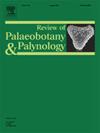Sweetea milowensis gen. et sp. nov., a Middle Mississippian (Viséan) pteridosperm preserved in a coastal marsh setting, Hartselle Sandstone, Alabama
IF 1.7
3区 地球科学
Q2 PALEONTOLOGY
引用次数: 0
Abstract
The Mississippian (Lower Carboniferous) is a time of terrestrial plant diversification and experimentation of growth architectures. Yet, the majority of taxa in which leaves are known conform to a bipinnate, tripinnate, or quadripinnate leaf architecture. Simple, compound (pinnate) leaves are rare and uncommon. Sweetea milowensis is described as a new genus and species of a small, simple, compound leaf preserved as isolated, dehisced foliage in a Viséan marsh litter dominated by the cormose lycopsid Harsellea dowensis in the Black Warrior Basin, Alabama, USA. It is characterized by a naked petiole, exhibiting a flared, thickened base, and pinnatifid rachis comprised of bilobed and trilobed leaflets in a descending spacing toward its tip. Sweetea gen. nov. is compared with coeval pteridophyte and pteridosperm megaphyll taxa, and it is suggested that the size of the plant's leaf may have been in response to saltwater spray or tidal incursion into the back barrier marsh. Arguments against whether Sweetea could represent a heterophyllous form of a previously described taxon, or the possibility that it is the product of heteroblastic development, are discussed. A review of the 33 commonly reported monopinnate, bipinnate, tripinnate, and quadripinnate Mississippian morphotaxa shows that only five of these possess a monopinnate-leaf architecture. And, amongst these, Sweetea is unique.
在阿拉巴马州哈特塞尔砂岩的沿海沼泽环境中保存的一种中密西西比(vissaman)翼种
密西西比期(下石炭世)是陆生植物多样化和生长结构试验的时期。然而,大多数已知叶的分类群符合两足、三足或四足叶结构。单叶,复叶(羽状)是罕见和不常见的。sweet tea milowensis被描述为一个新的属和种,它是一种小的、简单的复叶,作为分离的、裂开的叶子保存在美国阿拉巴马州黑战士盆地的vissaman沼泽凋落物中。它的特点是叶柄裸露,基部加厚,呈喇叭状,羽状轴由叶状叶和三叶小叶组成,叶状叶向叶尖方向递减。将甜茶与同时期的蕨类植物和巨型蕨类植物进行了比较,认为甜茶叶片的大小可能是对后屏障沼泽的盐水喷雾或潮汐入侵的反应。争论是否甜茶可能代表一个异叶形式的先前描述的分类单元,或它是异母发育的产物的可能性,进行了讨论。对33种通常报道的单生、双生、三生和四生的密西西比形态类群的回顾表明,其中只有5种具有单生叶结构。其中,甜茶是独一无二的。
本文章由计算机程序翻译,如有差异,请以英文原文为准。
求助全文
约1分钟内获得全文
求助全文
来源期刊
CiteScore
3.50
自引率
21.10%
发文量
149
审稿时长
6 months
期刊介绍:
The Review of Palaeobotany and Palynology is an international journal for articles in all fields of palaeobotany and palynology dealing with all groups, ranging from marine palynomorphs to higher land plants. Original contributions and comprehensive review papers should appeal to an international audience. Typical topics include but are not restricted to systematics, evolution, palaeobiology, palaeoecology, biostratigraphy, biochronology, palaeoclimatology, paleogeography, taphonomy, palaeoenvironmental reconstructions, vegetation history, and practical applications of palaeobotany and palynology, e.g. in coal and petroleum geology and archaeology. The journal especially encourages the publication of articles in which palaeobotany and palynology are applied for solving fundamental geological and biological problems as well as innovative and interdisciplinary approaches.

 求助内容:
求助内容: 应助结果提醒方式:
应助结果提醒方式:


